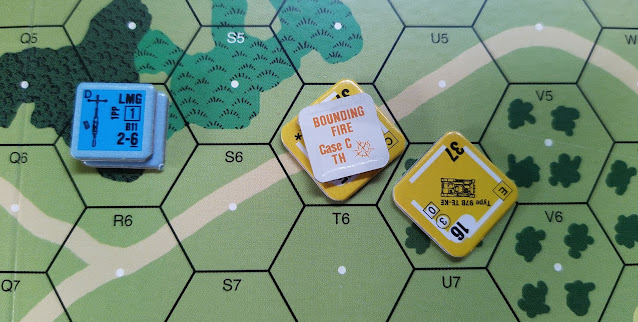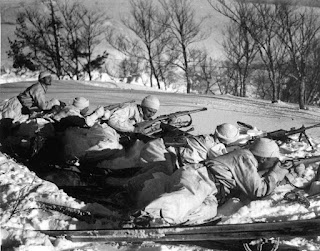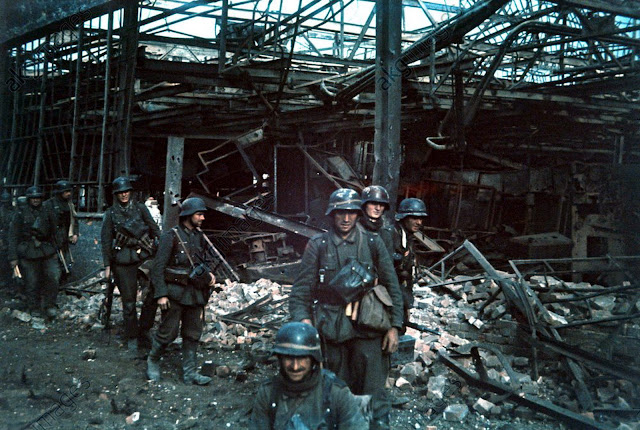Newbie Do - Rules Deep Dive - Critical Hits
Our first example occurs in the deep (and
slightly pink) heart of Stalingrad. A Stug III B is positioned close to the
Commissar's House and in the Russian turn the active player has advanced a
concealed stack consisting of a 6-2-8 a Heavy machine gun and a 9-2 officer into the edge of the Commissar's House at BB18.
The German defender decides to shoot now so
his/her first step is to work out the base numbers
The base to hit number is 8
There are no modifications from table C4 for
ammo at this close range so the modified to hit is also 8.
The player can now look at the C5 modifiers
and we have
Case I (Buttoned up ) +1
C6 modifiers
Case K (concealed target) +2
Case L (point blank range 1 hex) -1
Case Q (TEM - stone building) +3
For total dice modifiers of +5.
The dice are now rolled and glory of glories
a double one is rolled. We now pause while the Russian player curses and moans they only get snake eyes for wind rolls while the German player tries to
contain his unbounded cheer…
Once done the players start to work out the
results
The ORIGINAL DR is 2
Add the dice modifiers of +5 makes 7 which is
under the MODIFIED TO HIT number of 8 but obviously not less than half the
modified. So a critical hit is not guaranteed. The German player now has to
roll a single dice and will obtain a critical hit with a roll of 1,2,3 or 4
(less than or equal to half the MODIFIED TO HIT of 4) and a normal hit with 5,6.
In our example he rolls a 4 and obtains a
critical. The 75mm gun is a base 12 on the IFT it doubles to 24 with minus 3
for the tem now counting as a negative. On an average roll of 7 the Russians
lose concealment and face a 1KIA, a 12 would cause a 2MC (random dice roll needed to work out if the squad or officer (or both) takes the critical)
At this point a large portion of the
readership is mumbling 'yes but the hit would only occur with a roll of 2 or 3
so it was a lucky shot anyway'
'Absolutely' so lets setup a different
example.
Scuttling back to the Early War we have an
early British Cruiser tank minding its own business when a dastardly concealed
German stack advances behind it into the stone building in hex K9. Though the British player doesn't know it the
stack contains a 4-6-7 with an ATR looking to cause trouble with the tank's weak rear armour. The jokes on the Germans though as that tank has weak armour everywhere.... The valiant
British defender briefly considers spinning and firing his (not too shabby)
machine guns but the VCA spin and concealed half firepower would drop them to a 2 up 2.
Instead he decides to fire his main armament.
He spins the entire VCA 3 hexes and then
takes an initial shot
BASE TH is 8
MODIFIED TH is also 8
C5 modifiers are
A (vca change so NT (No Turret) +3 and +1 and +1) +5
I Buttoned up +1
C6 modifiers are
K (concealed) +2
Q (TEM - wooden building) +2
Total DRM modifiers are therefore an
unpleasant +10
The to hit roll is now made and the British
player rolls an ORIGINAL DR of 2
Add the modifiers and the FINAL DR is an
unsurprising 12 and 'might' be a miss by a mile.
C3.6 now applies as any hit that with the
lowest possible original DR cannot be made could still be a hit. The British
player rolls a single dice roll. If they roll a '1' then it is a critical hit
and if they roll a 2 or 3 then it is a normal hit (4,5,6 are a miss). In this
case the British player rolls a 5 and misses.
The player did though rate the Main Armament
and as it took 2 MF to get into the building he resolves to shoot again on the second movement point. The
BASE TH and the MODIFIED TH remain the same but of the dice roll modifiers
Case A goes (the tank cannot gain an acquire on the first shot as you cannot acquire concealed units - unless shooting ATT) for a more
'feasible' total of +5.
The player rolls again and this time makes an
original dice roll of three (coloured 1 white 2). Again we stop while the German player glares and considers leaving the room temporarily.
Three plus the Dice roll modifiers pushes the
FINAL TH Number to eight. So this is a hit but as the FINAL TH is not less
than half the modified (three, and though the ORIGINAL DR is 3 the FINAL DR is
used so '8') he gets a normal hit.
This will be an unimpressive 4 flat on the IFT.
All hail weapons with rate! Admittedly that example was hardly less 'lucky' so let's try again...
It is near the end of the war now and some
German infantry (a 10-2 and a 4-6-7) are trying to escape of board along
Q10,R10 and S10. Nasty residual exists on two of the hexes so they are using
the last free hexside and have entered S10 in a desperate attempt to get off board this turn. The British defender though has a Comet sitting on a
hill (as you do) and takes a shot as they move in.
The British player starts as before with section C3.
At 13 hex range the BASE TH number is 6.
They look at table C4 to calculate the
MODIFIED TH number and as the Comet carries a 'L' gun this makes the
MODIFIED TH number '7'
The players again look at C5 and there are no
adjustments so shift to C6
Here we have
Case J (FFNAM/FFMO (each) so -2
The British player now rolls an ORIGINAL DR
of '5' (coloured 3 white 2)
5 minus the DR MODIFIERS drops the result to
a 3 and as 3 is less than half the MODIFIED TH number of 3.5 it is a critical
hit with no further single dice rolls needed. (So the British player would have
gained a critical hit on a roll of 2,3,4 or 5 - a 28% chance of rolling a
critical hit ( and a roll of 6-9 would get a normal hit)
The result roll would therefore be a 24 flat
causing a potential 3MC with an average roll of 7 and a NMC minimum (without a
'dud') - as there are two units moving a random roll is needed to work out which takes the critical and which the normal hit (or both). Since the roll did not generate rate the British player also decides to
leave residual - a 6 factor residual counter is added to make all other following infantry face some unpleasant rolling (residual is half the normal hit value and not the critical hit value).
Example Four
For our final example we have a Japanese
light tank in its movement phase that has stopped in hex U6 and is taking a shot at a Vichy
French squad in a wood with a light machine gun. The tank in front is
non-stopped.
BASE TH is 8
MODIFIED TH is 8
DRM MODIFIERS are (+1 buttoned up, +1 tem, +2
case C (slow turret) and +2 case B) for a total of +6
The ORIGINAL DR made is double one so
the FINAL DR is 2 + 6 so is '8; which is exactly the same as the MODIFIED TH number.
The Japanese player now rolls a single dice
and any roll of 1,2,3,4 causes a critical hit (8 down 1 on the IFT) with 5,6 causing a
normal hit (4 flat). This example looks fairly close to example one but the key
point here is that the italiced sentence prior to the ITT section of C3.7 DOES
NOT APPLY to ITT attacks











Comments
Post a Comment